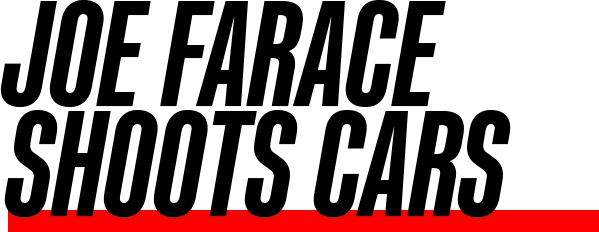Today’s Post by John Larsen
The basic techniques that are required to cover a motorsports event can essentially be broken down into four categories: panning, head-on, three-quarter and close-ups.
 Panning photos with visual impact require a blurred background and spinning wheels but with a sharp point of focus. This is achieved by firing your camera while smoothly following the subject as it goes by. The photographer must start to follow the subject and rotate smoothly while simultaneously pressing the shutter button. When I shoot panned photos from a specific location, I start with a higher shutter speed of perhaps 1/500 sec and will gradually slow it down to as low as 1/30 sec. This process could be considered warming up in a similar fashion to what athletes or entertainers might do. Zoom lenses such as a 70-200mm are ideal for panning as you can zoom out to possibly include more than one vehicle, or zoom in to try and get a closer image of a driver in an open cockpit racecar.
Panning photos with visual impact require a blurred background and spinning wheels but with a sharp point of focus. This is achieved by firing your camera while smoothly following the subject as it goes by. The photographer must start to follow the subject and rotate smoothly while simultaneously pressing the shutter button. When I shoot panned photos from a specific location, I start with a higher shutter speed of perhaps 1/500 sec and will gradually slow it down to as low as 1/30 sec. This process could be considered warming up in a similar fashion to what athletes or entertainers might do. Zoom lenses such as a 70-200mm are ideal for panning as you can zoom out to possibly include more than one vehicle, or zoom in to try and get a closer image of a driver in an open cockpit racecar.
 For many years I did not utilize aperture priority as I did not feel that it was necessary. However, when I am shooting head-on images, I switch to aperture priority and set the aperture to the largest opening. The camera will then determine the fastest shutter speed possible given the lighting conditions and your specified ISO. This combination will usually result in a shallow depth-of-field and a blurred background. The longest lens that you can get your hands on is the best for these photos. Remember that this technique can also be used to take photos from behind your subject!
For many years I did not utilize aperture priority as I did not feel that it was necessary. However, when I am shooting head-on images, I switch to aperture priority and set the aperture to the largest opening. The camera will then determine the fastest shutter speed possible given the lighting conditions and your specified ISO. This combination will usually result in a shallow depth-of-field and a blurred background. The longest lens that you can get your hands on is the best for these photos. Remember that this technique can also be used to take photos from behind your subject!
 Three-quarter photos are usually of your subject as they are entering or exiting a corner. A successful three-quarter shot will contain a sharpness in the middle with blurred action or piece of track in front of, and behind, your subject. Given the variables of speed, location and angle of corners it is not possible to provide a specific shutter speed recommendation. The best method is to simply go out and try it and experiment with various settings. I would recommend a zoom lens such as a 70-200mm for this type of photo also as it allows for varying image cropping and location within a corner.
Three-quarter photos are usually of your subject as they are entering or exiting a corner. A successful three-quarter shot will contain a sharpness in the middle with blurred action or piece of track in front of, and behind, your subject. Given the variables of speed, location and angle of corners it is not possible to provide a specific shutter speed recommendation. The best method is to simply go out and try it and experiment with various settings. I would recommend a zoom lens such as a 70-200mm for this type of photo also as it allows for varying image cropping and location within a corner.
Most, but not all, venues will allow photographers to wander around the paddock area where the cars are prepared by their teams. This allows you to get close to your subject. Given this is the case a wide-angle lens will allow you to include more of a car within the frame or possibly some interior photos. I have started to use my Fuji S1 bridge camera with the fish-eye filter to achieve interesting perspectives.
Please note that the images accompanying this blog were taken without any media credentials.
John Larsen is this blog’s Senior International Travel Correspondent, whose website is www.photograffics.com.
